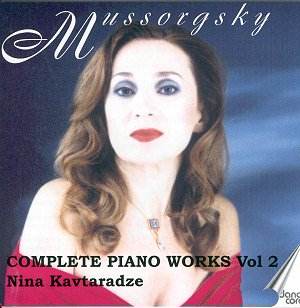It is ironic that the only piano piece by Mussorgsky
that most people will know is Pictures at an Exhibition in an
orchestral arrangement, usually the one by Ravel. Many people who know
it in this manifestation may never have heard it in the original and
therefore be missing out on a major contribution to 19th century piano
literature.
Most of this disc comprises Pictures at an Exhibition;
not that you would know it from the title of Complete Piano Works
Vol 2., which seems a strange way to sell this great work. However,
Danacord's project is a worthy venture but not without its problems.
Mussorgsky's keyboard output can be categorised as:–
1 works better known in others' orchestrations
2 works arranged for piano by Mussorgsky of his own
works
3 unfinished works.
Vol 2 here contains examples of all three.
Pictures at an Exhibition was in some ways a
victim of its own success. Unpublished in Mussorgsky's lifetime, when
it became known in western Europe it attracted many devotees at a time
when impressionism was in the air. It is ironic that Ravel's orchestration
of it is probably more performed than any of his own original works
apart from Bolero. Sviatoslav Richter did more than most in focusing
back on the original piano version of Pictures at an Exhibition,
giving it an airing in his recitals when he started to play in the West
in the 1960s. The trouble with this is that Richter's interpretation
has become an intimidating benchmark, casting a shadow (to mix a metaphor)
from which subsequent performers will find difficulty in escaping.
Nina Kavtaradze's playing is steady and sinewy. It
needs to be with music that is not pianistic in the Chopin sense but
abounds in fistfuls of consecutive chords and octaves. She has a hard
hitting, percussive approach to such passages, judicious use of the
pedal allowing for clarity of texture. In contrasting music of dreamy
textures and in light, rapid passage work she is a little less successful.
For example, in Gnomus, the second movement which comes after
the recurring Promenade music, the springy, downward slinking
chords could do with more limpid mystery. Nevertheless, her playing
of this number reminded me what radical piano writing this is. Coming
so near the beginning, no wonder the work had such immediate impact
in the West. In the fifth picture, Ballet of the unhatched chickens,
and in the seventh, The Market, there are examples of rapid scherzo-type
music and here I would have preferred more lightness of touch. But maybe
this is a mite unfair because I have Richter in mind and this is the
kind of thing at which he was unsurpassable. Overall, her playing has
a steady, consistent integrity that gives a sense of constructional
solidity to the piece, helping to convince that this a masterpiece of
keyboard composition.
Of the three other pieces on the disc, Hopak de
jeunes ukrainiens is well known for the same reason as Pictures
at an Exhibition. In this case it is Rimsky-Korsakov’s arrangement
that is often played and is the sort of piece that makes a good little
orchestral encore. The music comes from one of Mussorgsky’s many unfinished
works, this one being an opera called The Market in Sorotchinsk from
which the composer salvaged a few numbers by transcribing them for piano.
Another follows on the disc, Scène de foire, which is
an effective impression of the market itself.
Finally we have an unfinished original work for piano
duet which is a welcome curiosity rather than anything else. Mussorgsky
is clearly not at home in trying to mould his ideas into classical first
movement sonata form. We are reminded that in the impressionistic world
of Pictures at an Exhibition he was very much playing to his
strengths.
For those who do not have a recording of the original
Pictures at an Exhibition then this disc is certainly well worth
having. It combines an authoritative performance of a piano masterpiece
with some enjoyable and interesting fill ups.
John Leeman

![]() Nina Kavtaradze, piano
Nina Kavtaradze, piano
![]() DANACORD DACOCD 552
[56:47] Fullprice
DANACORD DACOCD 552
[56:47] Fullprice